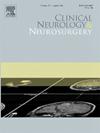Factors affecting the outcomes of tirofiban treatment in posterior circulation stroke
IF 1.8
4区 医学
Q3 CLINICAL NEUROLOGY
引用次数: 0
Abstract
Objective
Tirofiban is an effective treatment for ischemic stroke that is frequently used following early neurological deterioration (END). However, studies investigating the effects of tirofiban on patients with posterior circulation stroke (PCS) are scarce. Thus, this study aimed to explore factors affecting the outcomes of tirofiban in PCS.
Methods
The data of patients with PCS treated with tirofiban at our hospital were retrospectively collected. A modified Rankin scale (mRS) of 0–2 at 90 days was defined as a favorable outcome. A reduction in NIHSS after treatment compared with baseline NIHSS was defined as an early response to tirofiban. Patients' clinical characteristics and laboratory findings were analyzed to identify independent factors affecting the outcomes of tirofiban treatment.
Results
A total of 113 patients were enrolled in this study. 71 patients (62.8 %) exhibited favorable outcomes, whereas the remaining patients (37.2 %) had unfavorable outcomes. Hypertension and high NIHSS at admission were associated with unfavorable outcomes [(OR: 0.151, 95 % CI: 0.026–0.872; p = 0.035), (OR: 0.645, 95 % CI: 0.491–0.847; p < 0.001)], whereas high early response to tirofiban was significantly associated with favorable outcomes (OR: 1.913, 95 %CI: 1.390–2.631; p < 0.001). The cut-off value of early response to tirofiban to predict a favorable outcome was 0.5, with a sensitivity and specificity of 69 % and a Youden index of 0.38.
Conclusion
Early response to tirofiban had the highest predictive value on long-term outcomes of PCS patients treated with tirofiban.
影响替罗非班治疗后循环卒中疗效的因素。
目的:替罗非班是早期神经功能恶化(END)后经常使用的缺血性脑卒中的有效治疗方法。然而,关于替罗非班对后循环卒中(PCS)患者影响的研究很少。因此,本研究旨在探讨影响替罗非班治疗PCS预后的因素。方法:回顾性收集我院使用替罗非班治疗PCS患者的资料。改良的Rankin量表(mRS)在90天0-2被定义为良好的结果。与基线NIHSS相比,治疗后NIHSS的降低被定义为对替罗非班的早期反应。分析患者的临床特征和实验室结果,以确定影响替罗非班治疗结果的独立因素。结果:本研究共纳入113例患者。71例患者(62.8 %)表现出良好的结果,而其余患者(37.2% %)表现出不良的结果。入院时高血压和高NIHSS与不良结局相关[OR: 0.151, 95 % CI: 0.026-0.872;p = 0.035),(OR: 0.645, 95 % CI: 0.491-0.847;p 结论:替罗非班的早期反应对PCS患者的长期预后具有最高的预测价值。
本文章由计算机程序翻译,如有差异,请以英文原文为准。
求助全文
约1分钟内获得全文
求助全文
来源期刊

Clinical Neurology and Neurosurgery
医学-临床神经学
CiteScore
3.70
自引率
5.30%
发文量
358
审稿时长
46 days
期刊介绍:
Clinical Neurology and Neurosurgery is devoted to publishing papers and reports on the clinical aspects of neurology and neurosurgery. It is an international forum for papers of high scientific standard that are of interest to Neurologists and Neurosurgeons world-wide.
 求助内容:
求助内容: 应助结果提醒方式:
应助结果提醒方式:


